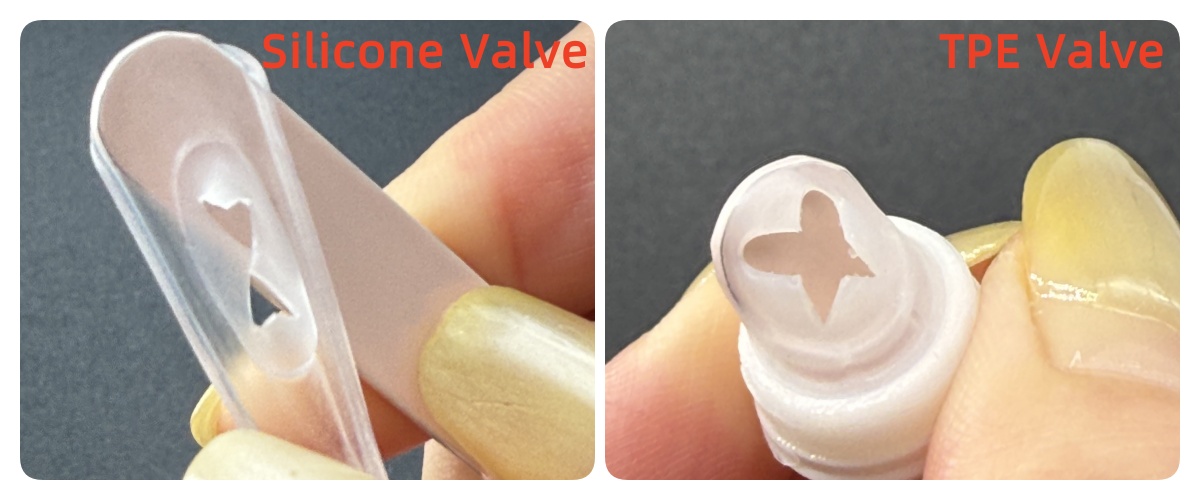Jun. 16, 2025
TPE Valve V.S. Silicone Valve: A Comprehensive Comparison for Modern Packaging Solutions
As the global packaging industry rapidly evolves, flexible valves have become a vital component in enhancing both product performance and user experience. Whether used in food and beverages, personal care products, or household cleaning solutions, flexible valves play a critical role in sealing, leak prevention, and dispensing control. Among the most commonly used materials for such valves are TPE (Thermoplastic Elastomer) Valves and Silicone Valves. In this article, we explore their differences across several key dimensions including material performance, slit design, sealing reliability, production costs, and application scenarios.
1. Material Performance: Silicone Excels in Elasticity and Durability
The physical properties of a valve material are crucial to its long-term performance and resilience. Silicone valves, made from high-transparency Liquid Silicone Rubber (LSR), offer excellent elasticity and rebound capability. Even after repeated squeezing, they retain their original shape and maintain a tight seal at the slit, ensuring smooth, controlled dispensing.
In contrast, TPE valves have lower elasticity due to their plastic-based composition. Over time and with repeated use, TPE is more prone to deformation and fatigue, leading to loosened slits, poor sealing, and inconsistent flow control.
✅ Conclusion: When it comes to elasticity and durability, silicone valves clearly outperform TPE valves.

2. Slit Design: Zero-Gap Precision vs. Imperfect Closure
The effectiveness of a flexible valve heavily depends on the precision of its slit cut structure. Silicone valves typically feature high-precision die-cut slits with a zero-gap design. This allows the valve to remain fully closed when not under pressure, eliminating leakage risks, and to open precisely when squeezed for controlled dispensing.
TPE valves, however, often show slight gaps in their slit design due to material softness and limitations in processing precision. These gaps can result in slow leaks, suction issues, or residue buildup inside the valve.
✅ Conclusion: Silicone's precise, gap-free slits deliver superior sealing and longer lifespan.

3. Leak-Proof Performance: Silicone Ensures Consistent Seal Integrity
Leak-proof is a critical function, particularly for inverted storage or high-pressure use cases. Thanks to their elasticity and tight slit closure, silicone valves offer excellent leak-proof performance. Even when stored upside down, they prevent drips and ensure accurate, mess-free dispensing — ideal for premium packaging where dosage precision matters.
TPE valves, with their weaker seal and lower elasticity, tend to suffer from "slow dripping" after extended use or in high-temperature conditions, making them less suitable for high-end or sensitive applications.
✅ Conclusion: Silicone valves provide superior sealing and dispensing reliability.
4. Cost Comparison: Balancing Development vs. Ready-Made Solutions
Silicone Valves benefit from a mature production ecosystem with a wide range of existing standard molds. This allows customers to purchase off-the-shelf options without the need for mold development, special machinery, or lengthy lead times — reducing initial investment despite the slightly higher raw material cost.
TPE Valves, while offering advantages such as recyclability and simplified assembly, require dual-shot injection molding using specialized equipment. This leads to high upfront costs for molds, machines, and quality testing equipment. Currently, there is also a lack of readily available TPE valve inventory in the China market, meaning development must start from scratch.
✅ Conclusion: Silicone valves are more cost-efficient for customers seeking fast deployment and lower initial investment, while TPE valves may be viable for large-scale, long-term projects with eco-recycling priorities.
5. Application Scenarios: Choosing the Right Valve for the Job
| Application Area | Recommended Material | Notes |
| Food & Beverage (e.g., honey, sauces, juice concentrates) | Silicone Valve/ TPE Valve (For Thick Liquids) | Silicone offers excellent sealing; TPE is recyclable and easy to assemble |
| Personal Care (e.g., shampoos, lotions, creams) | Silicone Valve/ TPE Valve (For Thick Liquids) | Silicone ensures anti-leak performance; TPE provides eco-friendly options |
| Household Cleaning (e.g., dish soap, kitchen cleaner) | Silicone Valve | Ideal for inverted packaging, leak-proof, and controlled dispensing |
✅ Conclusion: Silicone valves are better suited for mid-to-high-end applications where flow control, safety, and leak prevention are essential. TPE valves remain relevant for cost-sensitive, low-complexity applications.
Final Verdict: Silicone Valves Outperform in Quality-Critical Applications
When evaluating material resilience, slit structure, leak-proof reliability, cost-effectiveness, and application adaptability, silicone valves offer a stronger overall performance compared to TPE valves. With market trends favoring better packaging quality and user experience, silicone valves stand out as the optimal choice for many product lines. However, TPE valves still have a role to play in non-inverted, eco-conscious, and budget-focused solutions.
YEJIA has over 15 years of experience in silicone valve manufacturing. We offer a variety of ready-to-ship standard silicone valves, along with custom molding services led by an international team of engineers. If you're looking for high-performance silicone valve solutions, don't hesitate to contact us.



